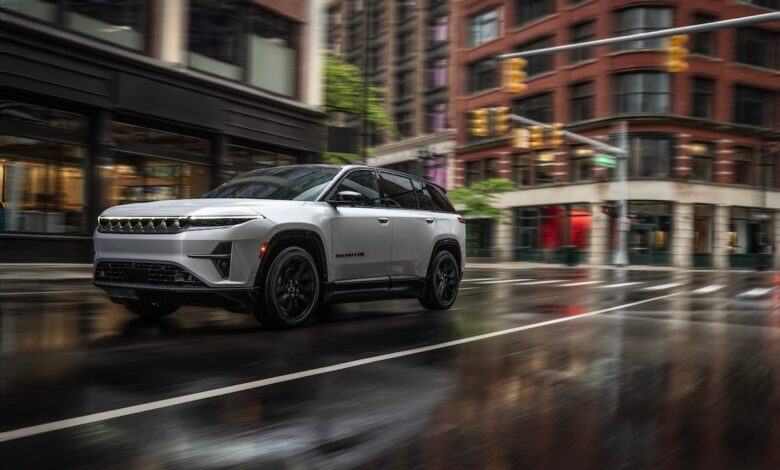Jeep reveals its first global all-electric vehicle – the Wagoneer S – a sleek, road-going SUV

The 2024 Jeep Wagoneer S Launch Edition.Stellantis/Courtesy of manufacturer
After months of teasing, Jeep has finally dropped the coyness and fully revealed the 2024 Wagoneer S, the brand’s first full battery-electric vehicle (BEV), at an event in downtown Manhattan on Thursday.
The “S” in its name is important, as it distinguishes the BEV from Jeep’s existing gas-powered Wagoneer and Grand Wagoneer SUVs, with which it shares absolutely no hardware or sheet-metal. The Wagoneer S is built on Stellantis’s new “EV-native” STLA-Large architecture and is a mid-size two-row SUV; its truck-based gas-powered namesakes are full-size three-rows.
In other departures from Jeep tradition, the Wagoneer S’s shape is sleek and aerodynamic, and it makes no pretense to be a rugged off-roader. As such, it fits with Jeep’s goal to extend the brand’s market coverage, using a strategy that Jeep chief executive officer Antonio Filosa described as “protect the core, broaden the reach.”
That said, Jeep surprised the media at the reveal event by also showing a Trailhawk concept of the S, with 75 millimetres more ground clearance, improved approach and departure angles, gnarly off-road tires and deep-water fording capability. Jeep didn’t say what powertrain it might have.
Public reaction will determine whether the Trailhawk reaches production. Meanwhile, the confirmed production Wagoneer S will debut as the Launch Edition – a high-performance luxury SUV with stats that include 600 horsepower, 617 lb-ft of torque, and a zero-to-60-miles-an-hour (97 kilometres per hour) time of 3.4 seconds.
The Launch Edition will go on sale in Quebec and B.C. this fall at a starting price of $88,995, with availability expanding to other provinces as production increases, Jeep says. We expect the lineup will also expand downward to include at least one more-affordable model with less-lavish amenities than the Launch Edition’s standard dual-pane panoramic opening sunroof, 19-speaker, 1,160-watt McIntosh audio system, interactive screen for the front passenger, heated and ventilated seating front and rear and a full suite of ADAS including Active Driving Assist.
The designers concocted a new illuminated ‘grille’ structure inspired by modern architecture.Jeremy Sinek/The Globe and Mail
Externally, the Wagoneer S introduces a reimagining of Jeep’s traditional seven-slot grille. Freed of the need to cool an internal combustion engine, designers concocted a new illuminated “grille” structure inspired by modern architecture. At the rear, a bold free-standing wing helps achieve a drag coefficient of 0.29 – very slippery for an SUV, and achieved without making the vehicle look like “a lozenge,” said design chief Ralph Gilles. That’s about 15 per cent lower than the average SUV.
On the electrics side, a 400-volt, 100-kilowatt-hour battery provides an estimated range of more than 480 kilometres. A 20-to-80 per cent recharge takes 23 minutes on a suitable DC fast charger, or a Level 2 charger will get you from 5 to 80 per cent in six to eight hours. Every Wagoneer S Launch Edition will include a 48-amp Level 2 home charger, or public charging credits of equal value through what Stellantis calls its “360-degree charging ecosystem,” Free2Move Charge.
Like most BEV SUVs, the Wagoneer S has an all-wheel-drive system based on electric motors at each end – in this case a pair of 250-kilowatt motors, each packaged into an Electric Drive Module that also integrates the gearing and the power electronics. The front EDM disconnects when cruising for greater efficiency.
Other than the Select-Terrain traction management system with Auto, Sport, Eco, Snow and Sand modes, the Launch Edition isn’t equipped for rock-crawling or river-fording: the suspension is fixed at a modest (by SUV standards) 6.4 inches of ground clearance.
Instead of back-country scenery, occupants can enjoy more than 45 inches of screenery, comprising a visually continuous display that spans the full width of the dashboard, plus an additional screen lower on the centre dash for climate controls. Yet, for all the acreage of screens, Gilles described a “detox approach” to the driver’s gauge cluster, which can be configured to show just a bare minimum of necessary information.
The cabin features wine red stitching.Stellantis/Courtesy of manufacturer
The cabin also features such details as “a refined cross-metal deco trim applique with a glazed laced pattern”, wine red stitching, an antimicrobial steering-wheel, electronic door release buttons and a new cool-touch “black ceramic-coated aluminum with haptic applique” on many touch-points.
“We banned wood,” said Gilles, “and we’re backing away from piano black,” noting too that there’s no chrome on the Wagoneer S, either inside or outside (the chrome plating process is environmentally toxic). A “huge push for sustainable materials” also includes a synthetic material where leather would traditionally be used.
While the Wagoneer S is pitched as a premium mid-size SUV, it will be joined next year by another SUV that officials also described as mid-size, but aimed at the mainstream market. It is likely to replace the Cherokee (though maybe with a different name) and will offer a variety of powertrains in various degrees of electrification.
Meanwhile, at around the time the city-slicker Wagoneer S comes to market this fall, Jeep will also reveal full details on the Recon, which will be based on the STLA-Large architecture, but more like a BEV interpretation of the hard-core off-road Wrangler.
The writer was a guest of the automaker. Content was not subject to approval.
Shopping for a new car? Check out the Globe Drive Build and Price Tool to see the latest discounts, rebates and rates on new cars, trucks and SUVs. Click here to get your price.



